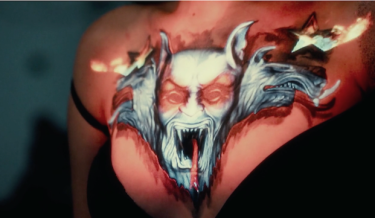At what point is documentary footage no longer a reflection of reality, but instead a clever manipulation of it? Is it possible for video to produce hyper-divergent experiences each time a viewer views it? These are but a glimpse of the questions probed by FLY, artist Meriem Bennani‘s ongoing, immersive video installation at MoMA PS1.
FLY, the New York-based artist’s first institutional, solo exhibition, occupies an isolated room on PS1’s ground floor, where Bennani has installed a series of geometric shapes, irregular protruding panels, and a mirrored staircase on three walls, upon which heavily edited footage from trips to her native country of Morocco are projected. A fourth wall shows a projected cascade of iPhones, wrist watches, and other capitalist goods floating downward endlessly.
Installation view of Meriem Bennani: FLY at MoMA PS1, 2016.
The clips Bennani has recorded in Morocco, including scenes from a wedding, footage from a rollerblading rink, and quiet domestic interiors, are shown in diverging mapped projections throughout the room. They are impossible to follow in their entirety. Instead, the viewer must make a conscious decision of what they absorb and what they ignore. As Bennani tells The Creators Project, “I conceived of the installation like a flexible playground for story-telling and video-editing that I kept in mind while shooting.”
Installation view of Meriem Bennani: FLY at MoMA PS1, 2016.
Although the footage is captivating in its own right, it’s FLY’s editing that makes it a memorable installation. The post-production goes beyond your run-of-the-mill color correction and cutting: an animated anthropomorphic fly narrator, Looney Tunes-esque sound effects, blob-like special effects, and other cartoony editing transform the documentary footage into a surreal satire of inherently unfunny scenarios. As an older woman tells a grave story about encountering a man who died of a heart attack, Bennani adds vibrant, over-the-top captions of her retelling that would feel more at home in a comic book than in a documentary.
“I think the primary use of cartoon is its existence as a language co-existing with journalistic videography, documentary, soap-opera, reality TV, internet humor, advertising strategies and so on,” Bennani explains. “I think that a lot of the genres cited above use cartoony devices because they are dialects simplified for instant communication purposes. I am interested in using the very simple language of cartoons because it is universal and accessible, and its efficiency can be a very powerful tool if carefully used to go against the tropes it relies on.”
One of the first 3D drawings of the installation.
Out of all the cartoonish editing, the narrating fly designed by the artist’s friend Kyung Hee Jwa, stands out as the most striking recurring element. Most of the time, the fly is merely a guide to the viewer, providing commentary from the sidelines of the screen without drawing too much attention to itself. In other moments, it blows up to enormous proportions and fills all of the different projections simultaneously while addressing the viewer head on.
Installation view of Meriem Bennani: FLY at MoMA PS1, 2016.
“I thought a fly was the perfect choice to give the viewer a tour of Medina because their compound vision made total sense with the multi-channel aspect of the show,” explains Bennani. “What interests me the most in this very literal analogy is that it establishes the fly character as a device. She functions as another cellphone or product of globalization in the video.”
Installation view of Meriem Bennani: FLY at MoMA PS1, 2016.
FLY is on view at MoMA PS1 until August 28th. More of Meriem Bennani’s work, including a reality TV show about an imaginary hijab designer, can be found here.
Source Creators
Follow our FB page Lumen




